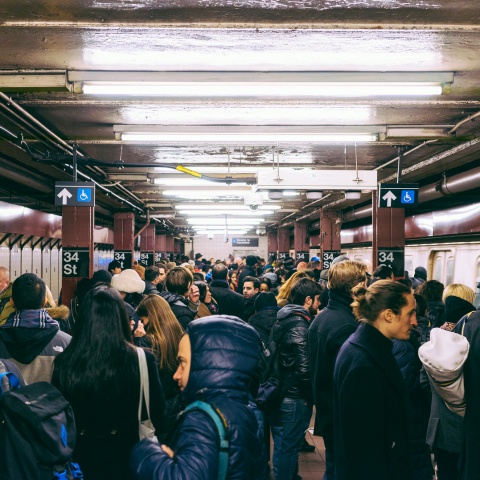Future City Lab: Transportation
How might we deal with overcrowding on our subways?
Interdisciplinary

Time Estimate: 45 minutes
Connection to Future City Lab: Getting Around: How can we make it easier for people to get into and around the city?
Objectives:
Students will:
-
Be able to identify some reasons why subways are overcrowded
-
Be able to select and support some solutions to overcrowding
Materials:
-
Smartboard or interactive board for brainstorming
-
Photos from slideshow: project first for the class and print remaining three for small group work
-
Pencils
-
Sticky notes
-
Chart paper
-
Chart markers
Standards:
-
CCSS.ELA-Literacy.SL 2.1: Participate in collaborative conversations about grade 2 topics and text with peers and adults in small and larger groups.
-
CCSS.ELA-Literacy.SL 2.2: Recount or describe key ideas or details from a text read aloud or information presented orally or through other media.
-
CCSS.ELA-Literacy.RI 2.1: Ask and answer questions such as who, what, where, when, why and how to demonstrate understanding of key details in a text.
-
CCSS.ELA-Literacy.RI 2.3: Describe the connection between a series of historical events, scientific ideas or concepts, or steps in technical procedures in a text.
Guiding Questions:
-
How can we improve the New York City subway system?
-
What are some possible solutions to help reduce the overcrowding in New York’s subways?
- Do In Advance
- Introduction (5 minutes)
- Group Work (30 minutes)
- Share-Out and Conclusion (10 minutes)
Procedures
In this lesson, students will be encouraged to think about overcrowding in subways. They will be introduced to the problem via group discussion and then pair off to evaluate three potential solutions. The class will come together to discuss some of the pros and cons that they identified for each solution and be encouraged to think of other possible approaches as the lesson ends.
In advance of the lesson, review the following articles from The New York Times:
“Every New York City Subway Line Is Getting Worse. Here’s Why.” (New York Times, June 28, 2017)
Key takeaway: “The subway is a victim of its own success and the city’s resurgence. Large crowds slow down trains, which creates more crowding in a vicious circle that takes hours to unwind during every rush.”
“Key to Improving Subway Service in New York? Modern Signals.” (New York Times, May 1, 2017).
Key takeaway: The second-most common reason for delays is the subway’s antiquated signal system, parts of which date to the 1930s. It could take a half-century and $20 billion to upgrade the signal system on every line.
If you find any visualizations useful and have a computer-connected projector, consider showing them to the class during discussion.
Project first image from the slideshow. Have students sit with a partner.
Ask: Today we’re talking about the New York City subway system. More and more people are riding the subway. Let’s look at the picture. What do you see?
Have each partner turn and talk about the picture. Use the sentence stem: “I can see…”
Share responses with the rest of class and record on the board or chart paper.
Ask and chart responses:
What are some challenges of riding the subway?
How can we help people get to where they’re going quickly and safely?
Explain the key takeaways from the “Do In Advance” teacher reading: that two of the most important factors are overcrowding and out-of-date signals. Note that today’s lesson will focus on overcrowding.
Break students into three groups. Each group will cycle (in partners) between three stations. Place at each station one of the provided print-outs that shows a solution to subway overcrowding and a large piece of chart paper with a T-square (“good idea” and “bad idea”) where students can post their reactions.
Station One: Open-Gangway Subway Cars
Station Two: Build More Subway Lines
Station Three: Build Longer Platforms and Longer Trains
Have students work with their partner at each station. Encourage them to focus on the following questions:
What do you see?
Identify the solution.
Is it a good idea or a bad idea? Why or why not?
Have students write responses on sticky notes and print their name at the bottom. Then they can put their notes on the chart paper within the appropriate side of the T-square.
Rotate groups after 10 minutes.
After everyone has cycled through the stations, allow students to walk around and review comments. Have them return to their seats for a final discussion.
Discuss: Have students talk through the options as a group.
Ask: What did you notice about the options? Were any of them all good or all bad? Are some better to do in the short-term versus the long-term? What else do you think we need to think about as we try to solve this problem?
These are not the only ways we can relieve subway overcrowding. Can anybody else think how we can help people get quickly and safely through the city?
Optional extension: The target “dwell time” for trains in each station is 30 seconds. Encourage students to time their train on their next subway ride and chart the train’s dwell time at each station.
Additional Resources
Linda Poon, “NYC Finally Gets On Board with the Subway Car of the Future.” CityLab, February 1, 2016: https://www.citylab.com/transportation/2016/02/nyc-finally-gets-on-board-with-the-subway-car-of-the-future-open-gangway/459300/
Fieldtrips: This content is inspired by the Future City Lab gallery in the Museum’s flagship exhibition, New York at Its Core. If possible, consider bringing your students on a fieldtrip! Visit http://mcny.org/education/field-trips to find out more.
Acknowledgements
This series of lesson plans for New York at Its Core was developed in conjunction with a focus group of New York City public school teachers: Joy Canning, Max Chomet, Vassili Frantzis, Jessica Lam, Patty Ng, and Patricia Schultz.
This project was made possible in part by the Institute of Museum and Library Services.
The views, findings, conclusions or recommendations expressed in these lessons do not necessarily represent those of the Institute of Museum and Library Services.

